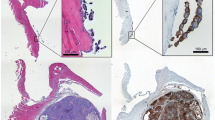Summary
We studied the effect of monoclonal antibody protein dose on the uniformity of radioiodinated antibody distribution within tumor masses using quantitative autoradiography. Groups (n = 11–13/group) of athymic nude mice with subcutaneous HTB77 human ovarian carcinoma xenografts were injected intraperitoneally with an125I-labeled anticarcinoma-associated antigen murine monoclonal antibody, 5G6.4, using a high or a low protein dose (500 µg or 5 µg). At 6 days post-injection the macroscopic and microscopic intratumoral biodistribution of radiolabeled antibody was determined. The degree of heterogeneity of the labeled antibody distribution within each tumor was quantified and expressed as thecoefficient of variation (CV) of the activity levels in serial histological sections. Tumors from mice given the 500-µg protein doses had substantially lower CV values, 0.327±0.027, than did tumors from animals given 5-µg protein doses, 0.458±0.041, (P = 0.0078), indicating that the higher protein dose resulted in more homogeneous distribution of radioactivity in tumors than did the lower dose. While the percentage of the injected dose reaching the tumor was comparable between groups, injecting the higher dose of protein resulted in significantly lower tumor to non-tumor uptake ratios than those obtained for the lower protein dose. These data indicate, in this system, that to achieve more uniform intratumoral antibody (and radiation for radioimmunotherapy) delivery, a relatively high protein dose must be administered. However, to obtain this increased uniformity, a substantial drop in tumor/background uptake ratios was seen. Quantitative autoradiographic evaluation of human tumor xenografts is a useful method to assess the intratumoral distribution of antibodies.
Similar content being viewed by others
References
Badger CC, Krohn KA, Shulman H, Flournoy N, Bernstein ID (1986) Experimental radioimmunotherapy of murine lymphoma with 131I-labeled anti-T-cell antibodies. Cancer Res 46: 6223–6228
Blumenthal RD, Fand I, Sharkey RM, Boerman OC, Kashi R, Goldenberg DM (1991) The effect of antibody protein dose on the uniformity of tumor distribution of radioantibodies: an autoradiographic study. Cancer Immunol Immunother 33: 351–358
Bradford M (1976) A rapid and sensitive method for the quantitation of microgram quantities of protein utilizing the principle of proteindye binding. Anal Biochem 72: 248–255
del Rosario RB, Baron LE, Lawton RG, Wahl RL (1992) Streptavidin-biotinylated IgG conjugates: a simple procedure for reducing polymer formation. Technical note. Nucl Med Biol 19: 417–421
Esteban JM, Schlom J, Mornex F, Colcher D (1987) Radioimmunotherapy of athymic mice bearing human colon carcinomas with monoclonal antibody B72.3: histological and autoradiographic study of effects on tumors and normal organs. Eur J Cancer Clin Oncol 23: 643–655
Fenwick JR, Philpott GW, Connett JM (1989) Biodistribution and histological localization of anti-human colon cancer monoclonal antibody (MAb) 1A3: the influence of administered MAb dose on tumor uptake. Int J Cancer 44: 1017–1027
Fraker PJ, Speck JC (1978) Protein and cell membrane iodinations with a sparingly soluble chloroamide, 1,3,4,6-tetrachloro-3l,6l-diphenylglycoluril. Biochem Biophys Res Commun 80: 849–857
Fujimori K, Covell DG, Fletcher JE, Weinstein JN (1989) Modeling analysis of the global and microscopic distribution of immunoglobulin G, F(ab′)2, and Fab in tumors. Cancer Res 15; 49: 5656–5663
Fujimori K, Fisher DR, Weinstein JN (1991) Integrated microscopicmacroscopic pharmacology of monoclonal antibody radioconjugates: The radiation dose distribution. Cancer Res 15; 51: 4821–4827
Griffith MH, Yorke ED, Wessels BW, DeNardo GL, Neacy WP (1988) Direct dose confirmation of quantitative autoradiography with micro-TLD measurements for radioimmunotherapy. J Nucl Med 29: 1795–1809
Hsu SM, Raine L, Fanger H (1981) Use of avidin-biotin-peroxidase complex (ABC) in immunoperoxidase techniques: comparison between ABC and unlabeled antibody (PAP) procedures. J Histochem Cytochem 29: 577–580
Jain RK (1989) Delivery of novel therapeutic agents in tumors: physiological barriers and strategies. J Natl Cancer Inst 81: 570–576
Jain RK (1990) Physiological barriers to delivery of monoclonal antibodies and other macromolecules in tumors. Cancer Res [Suppl] 50: 814s-819s
Joftes DL (1963) Radioautography, principles and procedures. J Nucl Med 4: 143–154
Key ME, Bernhard MI, Hoyer LC, Foon KA, Oldham RK, Hanna MG (1983) Guinea pig line 10 hepatocarcinoma model for monoclonal antibody serotherapy: in vivo localization of a monoclonal antibody in normal and malignant tissues. J Immunol 130: 1451–1457
Koral KF, Kwok CS, Yang FE, Wahl RL (1989) Variations in absorbed dose for radiolabeled monoclonal antibodies in a murine human-tumor xenograft. J Nucl Med 30: 777
Kwok CS, Cole SE, Liao SK (1988) Uptake kinetics of monoclonal antibodies by human malignant melanoma multicell spheroids. Cancer Res 48: 1856–1863
Moshakis V, McIlhinney RA, Neville AM (1981) Cellular distribution of monoclonal antibody in human tumours after I. V. administration. Br J Cancer 44: 663–669
Ong GL, Mattes MJ (1989) Penetration and binding of antibodies in experimental human solid tumors grown in mice. Cancer Res 1; 49: 4264–4273
Patt YZ, Lamki LM, Haynie TP, Unger MW, Rosenblum MG, Shirkhoda A, Murray JL (1988) Improved tumor localization with increasing dose of indium111-labeled anti-carcinoembryonic antigen monoclonal antibody ZCE-025 in metastatic colorectal cancer. J Clin Oncol 6: 1220–1230
Pervez S, Epenetos AA, Moor WJ, Evans DJ, Rowlinson G, Dhokia B, Krausz T (1988) Localization of monoclonal antibody AUAl and its F(ab′)2 fragments in human tumour xenografts: an autoradiographic and immunohistochemical study. Int J Cancer [Suppl] 3: 23–29
Sands H, Jones PL, Shah SA, Palme D, Vessella RL, Gallagher BM (1988) Correlation of vascular permeability and blood flow with monoclonal antibody uptake by human Clouser and renal cell xenografts. Cancer Res 48: 188–193
Schroff RW, Woodhouse CS, Foon KA, Oldham RK, Farrell MM, Klein RA, Morgan AC Jr (1985) Intratumoral localization of monoclonal antibody in patients with melanoma treated with antibody to a 250,000-dalton melanoma-associated antigen. J Natl Cancer Inst 74: 299–306
Sharkey RM, Primus FJ, Goldenberg DM (1987) Antibody protein dose and radioimmunodetection of GW-39 human colon tumor xenografts. Int J Cancer 39: 611–617
Sharkey RM, Natale A, Goldenberg DM, Mattes MJ (1991) Rapid blood clearance of immunoglobulin G2a and immunoglobulin G2b in nude mice. Cancer Res 15; 51: 3102–3107
Thomas GD, Chappell MJ, Dykes PW, Ramsden DB, Godfrey KR, Ellis JRM, Bradwell AR (1989) Effect of dose, molecular size, and protein binding on tumor uptake of antibody or ligand: a biomathematical model. Cancer Res 49: 3290
Wahl RL (1989) Radiolabeled monoclonal antibody imaging. Radiol Rep 1: 347–361
Wahl RL, Philpott GW, Parker CW (1983) Monoclonal antibody radioimmunodetection of human-derived colon cancer. Invest Radiol 18: 58–62
Wahl RL, Sherman P, Fisher S (1984) The effect of specimen processing on radiolabeled monoclonal antibody biodistribution. Eur J Nucl Med 9: 382–384
Wahl RL, Liebert M, Wilson BS (1986) The influence of monoclonal antibody dose on tumor uptake of radiolabeled antibody. Cancer Drug Deliv 3: 243–249
Wahl RL, Liebert M, Biesman B, Roberts J, Jackson G, Kronberg S, Laino L (1986) Production and characterization of a murine monoclonal antibody reactive with ovarian and other epithelial carcinomas. Proc Am Assoc Cancer Res 27: 355
Wahl RL, Barrett J, Geatti O, Liebert M, Wilson BS, Fisher S, Wagner JG (1988) The intraperitoneal delivery of radiolabeled monoclonal antibodies: studies on the regional delivery advantage. Cancer Immunol Immunother 26: 187–201
Wahl RL, Wissing J, del Rosario R, Zasadny KR (1990) Inhibition of autoradiolysis of radiolabeled monoclonal antibodies by cryopreservation. J Nucl Med 31: 84–89
Yang F, Brown RS, Koral KF, Jackson G, Clavo A, Wahl RL (1989) Quantitative autoradiographic evaluation of the influence of antibody protein dose on antibody distribution in human tumor xenografts. J Nucl Med 30: 759
Yonekura Y, Brill AB, Som P, Bennett GW, Fand I (1983) Quantitative autoradiography with radiopharmaceuticals, part I: digital filmanalysis system by videodensitometry: concise communication. J Nucl Med 23: 231–237
Author information
Authors and Affiliations
Rights and permissions
About this article
Cite this article
Yang, F.E., Brown, R.S., Koral, K.F. et al. Quantitative autoradiographic evaluation of the influence of protein dose on monoclonal antibody distribution in human ovarian adenocarcinoma xenografts. Cancer Immunol Immunother 35, 365–372 (1992). https://doi.org/10.1007/BF01789014
Received:
Accepted:
Issue Date:
DOI: https://doi.org/10.1007/BF01789014




